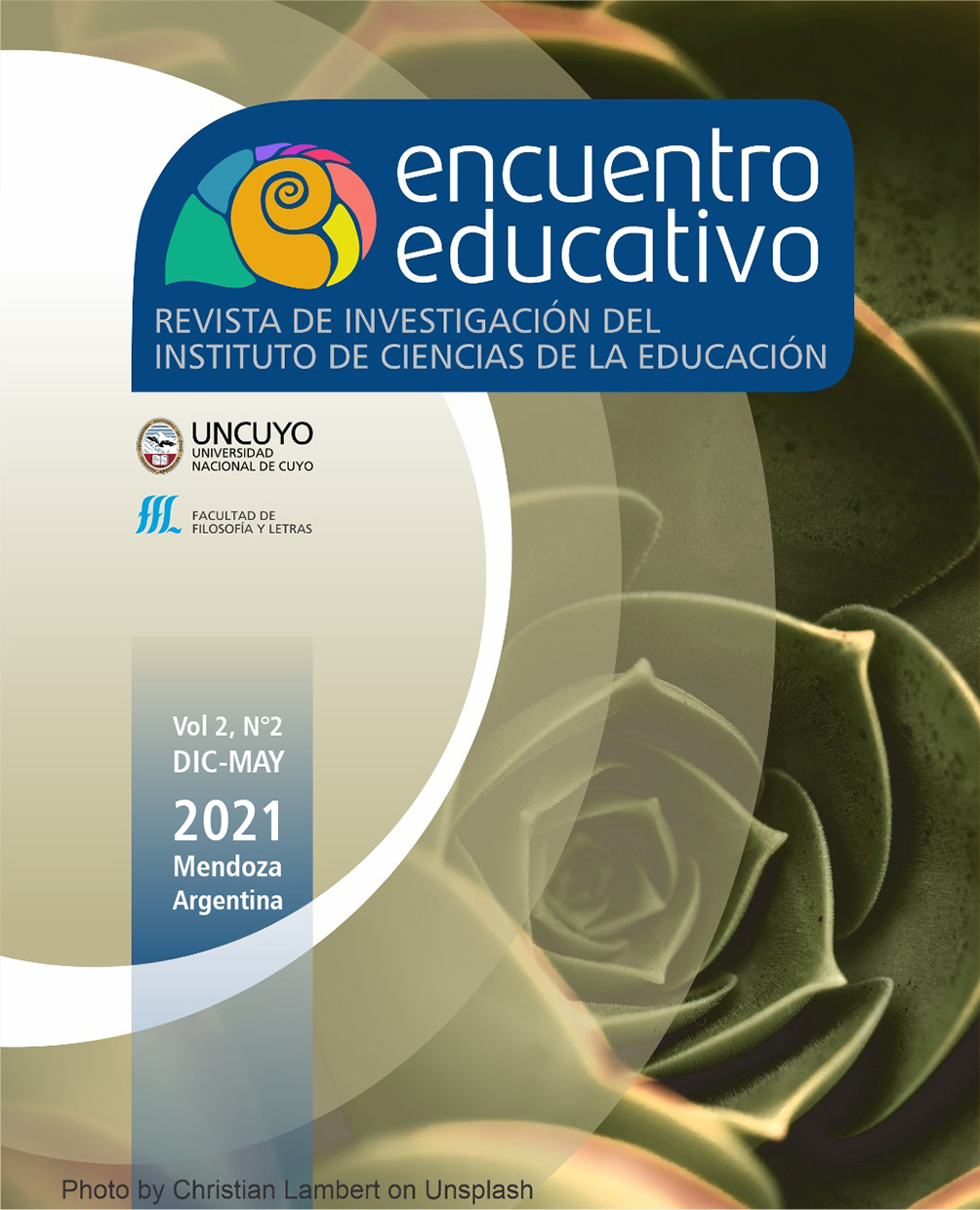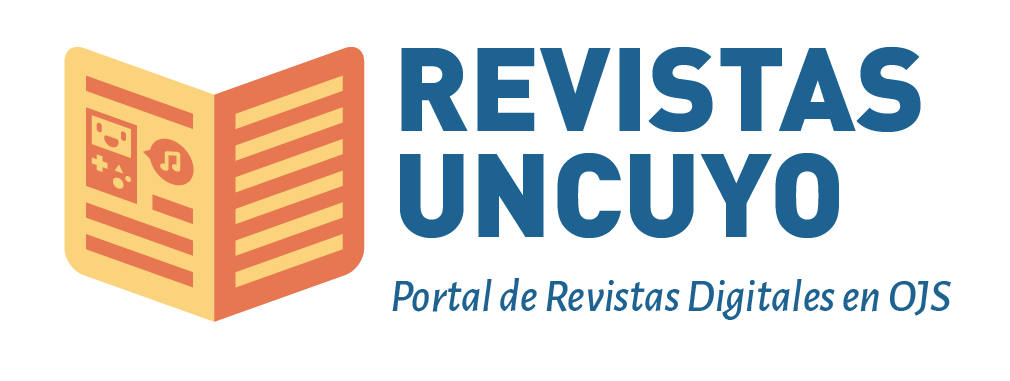Analysis of teaching practice using the Interconnected Model of Teacher Professional Growth. A case study during initial training.
Un estudio de caso durante la formación inicial
Keywords:
Initial teacher training, interconnected model of teacher professional growth, teaching residence, school scientific explanationsAbstract
In this qualitative study we recover and contextualize the Interconnected Model of professional teaching development (IMTPG) in the curricular space of the Teaching Residence. Our aim is to analyze how a future chemistry teacher questions aspects of her professional knowledge, revising her teaching practices in the classroom while teaching the construction of scholar scientific explanations.
The analysis was centered on the transcriptions of audio registers of her participation in an instance of socialization with peers and on her reflections in her class diary. We describe her learnings in terms of changes between four domains: Personal, External, of Practice and Consequences, and mediations (reflection, application) during her participation in the socialization instance (athenaeum) and
elaboration of the class diary.
The contents gathered through those instruments have been analysed, developing a system of categories, based on the domains and mediations proposed by the IMTPG, identifying the didactic problems recognised by the trainee. We also distinguished what types of relationships between domains were privileged with each device used. The results that we show in this article constitute progress of a
broader analysis centered on studying the professional development of the resident, considering the set of classes that delimit the didactic sequence referred to work with school scientific explanations and gaseous transformations in secondary education. These results exemplify how the IMTPG model is used in a
training context which has been scarcely investigated within this particular line of research, such as the one represented by the initial teacher training and especially
during Teaching Residency. We show how the model makes visible the reflective stages of a future teacher. In addition, we demonstrated how the devices were explored in order to promote reflective processes from the potentials offered, in order to facilitate the relationships across Domains. Finally we discuss possibilities and limitations of the study presented.
References
Avidov-Ungar, O. (2016). A model of professional development: teachers’ perceptions of their professional development. Teachers and Teaching, 22(6), 653-669. doi:10.1080/13540602.2016.1158955
Bell, P. y Linn, M. C. (2000). Scientific arguments as learning artifacts: Designing for learning from the web with KIE. International Journal of Science Education, 22(8), 797-817.
Berger, P. y Luckmann, T. (1991). La construcción social de la realidad. Amorrortu editores.
Borko, H. (2004). Professional development and teacher learning: Mapping the terrain. Educational Researcher, 33(8), 3-15.
Clarke, D. y Hollingsworth, H. (2002). Elaborating a model of teacher professional growth. Teaching and Teacher Education, 18(8), 947-967.
Cutrera, G., Massa, M. y Stipcich, S. (2020). Interacciones discursivas en el trabajo didáctico con explicaciones. Un estudio de caso centrado en la estructura de las explicaciones científicas escolares. Revista de Enseñanza de la Física, 32(2), 19-29.
de Vries, S., van de Grift, W. J. C. M. and Jansen, E. P. W. A. (2014). How teachers’ beliefs about learning and teaching relate to their continuing professional development. Teachers and Teaching, 20(3), 338-357. doi:10.1080/13540602.2013.848521
Edelstein, G. (2001). Formación práctica del profesorado. Más allá del ritual… Otros guiones, otras escenas. En M. A. Zabalza y Ma. L Iglesias Forneiro (Coord.) Innovaciones en el Practicum: V Symposium Internacional sobre el Practicum. Poio (Pontevedra), 29-30 junio y 1 de julio. ISBN 84-607-2511-1.
Edelstein, G. (2003). Prácticas y residencias: memorias, experiencias, horizontes…. Revista Iberoamericana de Educación, 33, 71-89. https://www.redalyc.org/pdf/800/80003306.pdf
Edelstein, G. (2015). La enseñanza en la formación para la práctica. Educación, Formación e Investigación, 1(1). Recuperado de: http://ppct.caicyt.gov.ar/index.php/efi/article/view/6219
Eder, M. L. y Adúriz Bravo, A. (2008). La explicación en las ciencias naturales y en su enseñanza: aproximaciones epistemológicas y didácticas. Revista Latinoamericana de estudios educativos, 4(2), 101-133.
Escudero, J. M., Bolívar, A., González, M. T. y Moreno, J. M. (1997). La reflexión y el análisis sobre la práctica. La formación y el aprendizaje de la profesión mediante la revisión de la práctica. En J.M. Escudero, A. Bolívar, M.T. González y J.M. Moreno (Ed.), Diseño y desarrollo del currículum en la educación secundaria. Vol. 7 (pp. 157-165). Horsori.
Feiman-Nemser, S. (1983). Learning to teach. State University.
Ferry, G. (1991). El trayecto de la formación. Paidós.
Ferry, G. (1997). Pedagogía de la formación. Ediciones Novedades Educativas.
Fullan, M. (2007). The new meaning of educational change. Routledge.
Gimeno Sacristán, J. (1992). Profesionalización docente y cambio educativo. En A. Alliaud y L. Duschatsky
(comp). Maestros, Formación, práctica y transformación escolar. Miño y Dávila Editores.
Gimeno Sacristán, J. (1999). Poderes inestables en educación. Morata.
Guskey, T. R. (1986). Staff development and the process of teacher change. Educational Researcher, 15(5), 5-12.
Guskey, T. R. (2002). Professional development and teacher change. Teachers and Teaching, 8(3), 381-391. http://keystoliteracy.com/wp-content/pdfs/orc-implement-science/PD%20and%20Teacher%20Change.pdf
Hilton, A., Hilton, G., Dole, S. y Goos, M. (2015). School leaders as participants in teachers’ professional development: The impact on teachers’ and school leaders’ professional growth. Australian Journal of Teacher Education, 40(12), 8. https://ro.ecu.edu.au/cgi/viewcontent.cgi?referer=https://scholar.google.es/&httpsredir=1&article=2986&context=ajte
Johnstone, A. (2000). Teaching of chemistry-logical or psychological? Chemistry Education Research and Practice, 1(1), 9-15.
Justi, R. y Van Driel, J. (2006). The use of the interconnected model of teacher professional growth for understanding the development of science teachers’ knowledge on models and modelling. Teaching and Teacher Education, 22(4), 437-450.
Kenyon, L. y Reiser, B. J. (2006). A functional approach to nature of science: Using epistemological understandings to construct and evaluate explanations. Paper presented at the Annual Meeting of the American Educational Research Association (AERA), San Francisco, CA.
Korthagen, F. A., Kessels, J., Koster, B., Lagerwerf, B. and Wubbels, T. (2001). Linking practice and theory: The pedagogy of realistic teacher education. Routledge.
Litwin, E. (1996). El campo de la didáctica: La búsqueda de una nueva agenda. En A. Camilloni, M.C. Davini, G. Edelstein, E. Litwin, M.Souto y S. Barco (Comp.). Corrientes didácticas contemporáneas, 91-116. Buenos Aires: Paidós.
Lotter, C., Harwood, W. S. y Bonner, J. J. (2006). Overcoming a learning bottleneck: Inquiry professional development for secondary science teachers. Journal of Science Teacher Education, 17(3), 185-216.
Marcelo, C. (2011). La evaluación del desarrollo profesional docente. En: Aprendizaje y desarrollo profesional docente (pp. 119-128). Organización de Estados Iberoamericanos para la Educación, la Ciencia y la Cultura (OEI).
Marcelo, C. y Vaillant, D. (2010). Desarrollo profesional docente: ¿cómo se aprende a enseñar? (Vol. 115).
Narcea Ediciones.
McNeill, K. L. y Krajcik, J. (2006). Supporting students’ construction of scientific explanation through generic versus context-specific written scaffolds. Paper presented at the Annual Meeting of the American Educational Research Association, San Francisco.
Mortimer, E. y Scott, P. (2003). Meaning Making In Secondary Science Classrooms. McGraw-Hill Education (UK).
Nilsson, P. (2008). Teaching for understanding: The complex nature of pedagogical content knowledge in pre-service education. International Journal of Science Education, 30(10), 1281-1299.
Ogborn, J., Kress, G. y Martins, I. (1996). Explaining science in the classroom. McGraw-Hill Education (UK).
Olivé, A. M. (2009). El desarrollo profesional docente y la mejora de la escuela. En C. Vélaz de Medrano y D. Vaillant (Eds.), Aprendizaje y desarrollo profesional docente (pp. 99-108). Organización de Estados Iberoamericanos para la Educación, la Ciencia y la Cultura (OEI).
Peter-Koop, A. y Clarke, D. J. (1993). Modelling teacher change. Paper presented at the Proceedings of the 16th Annual Conference of the Mathematics Education Research Group of Australasia.
Pérez Gómez, Á. (1997). Socialización profesional del futuro docente en la cultura de la institución escolar: el mito de las prácticas. Revista Interuniversitaria de Formación del Profesorado, 29, 125-140.
Salomon, G. y Perkins, D. N. (1998). Individual and social aspects of learning. Review of Research in Education, 23(1), 1-24.
Sandoval, W. y Reiser, B. (2004). Explanation-driven inquiry: Integrating conceptual and epistemic scaffolds for scientific inquiry. Science Education, 88(3), 345-372.
Schön, D. (1998). El profesional reflexivo: cómo piensan los profesionales cuando actúan. Paidós.
Shulman, L. (1987). Knowledge and teaching: Foundations of the new reform. Harvard Educational Review, 57(1), 1-23.
Stake, R. (2012). El estudio de casos cualitativos. En N.K. Denzin, y Y. S. Lincoln, (Ed.), Estrategias de investigación cualitativa, (Vol. III, (pp. 154-197). Gedisa.
Sweeney, A. E. (2003). Articulating the Relationships Between Theory and Practice in Science Teaching: A model for teacher professional development. Teachers and Teaching, 9(2), 107-132. doi:10.1080/13540600309375
Taber, K. (2013). Revisiting the chemistry triplet: drawing upon the nature of chemical knowledge and the psychology of learning to inform chemistry education. Chemistry Education Research and Practice, 14(2), 156-168.
Taylor, S. y Bogdan, R. (1987). Introducción a los métodos cualitativos de investigación. Paidós.
van Driel, J. H., Meirink, J. A., van Veen, K. and Zwart, R. C. (2012). Current trends and missing links in studies on teacher professional development in science education: a review of design features and quality of research. Studies in Science Education, 48(2), 129-160.
Veel, R. (1997). Learning how to mean—scientifically speaking: Apprenticeship into scientific discourse in the secondary school. In F. Christie y J. R. Martin (Eds.), Genre and institutions: Social processes in the workplace and school (pp. 161-195). Continuum.
Widjaja, W., Vale, C., Groves, S. y Doig, B. (2017). Teachers’ professional growth through engagement with lesson study. Journal of Mathematics Teacher Education, 20(4), 357-383.
Wilkie, K. J. y Clarke, D. (2015). Pathways to Professional Growth: Investigating Upper Primary School Teachers' Perspectives on Learning to Teach Algebra. Australian Journal of Teacher Education, 40(4), 87-118.
Zimmerman, C. (2007). The development of scientific thinking skills in elementary and middle school. Developmental Review, 27(2), 172-223.













